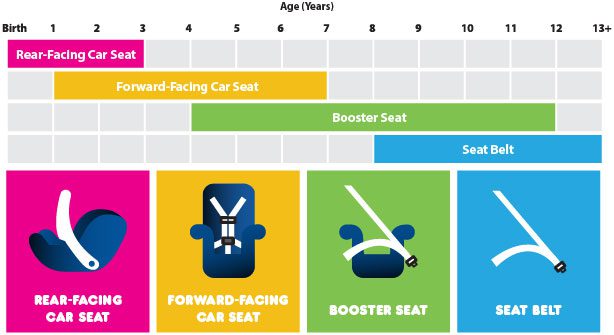Car seats
Keeping your child safe in the car is an important aspect of parenting from the day you bring your infant home from the hospital. Since motor vehicle crashes represent the leading cause of death for children under the age of 3 years in the U.S. as well make up a substantial portion of other childhood injuries and fatalities, being careful about car seat choices can make a tremendous impact on the safety of your child. The American Academy of Pediatrics issued updated recommendations in 2011 to help guide you in safely securing your children in a car.
Infants and toddlers should remain in a rear facing car seat until age 2 or until they reach the maximum height and weight restrictions for their particular seat. Practically, most infant car seats are graded to a maximum of 30 or 35 pounds which may suffice for some toddlers, though a many will likely need to be positioned rear-facing in a convertible “forward-facing” car seat sometime during the second year of life. This “forward-facing” car seat may subsequently be repositioned to face forward after your child turns 2 years old.
Rear-facing and forward-facing seats should be have their shoulder straps positioned at a height at or below shoulder height and the “retainer clip” (the clip that goes across your infant’s chest) should be at the level of your baby’s armpits.
Many infant seats and forward-facing car seats may be positioned either with a safety belt passed through the seat itself or a detachable base or by using a LATCH system lower anchor (hooks that attach to metal tethers in the back seat of your car) – most cars manufactured since 2002 are built with LATCH systems and these are safe for securing car seats for children who weigh up to 65 pounds. You may need to kneel forcefully into the seat while you tighten it in order to achieve a secure position independent of how you fasten the seat within the car.
Once children exceed the maximum height and weight restrictions for their forward-facing car seats, they should be positioned in a belt-positioning booster seat until they reach 4’9’’ in height and are between 8-12 years old. When only one child is in the back seat, the safest position in the car is the middle seat but cannot always be accomplished when traveling with multiple children. Children should avoid traveling in the front seat until they turn 13 years old.
Finally, all car seat products should have an “expiration date” printed them after which time the wear-and-tear has reduced their effectiveness.
NHTSA Car Seat Installation Tips
Written by: Dr. Ben Kornfeld
Image soure: http://www.safercar.gov/parents/Right-Seat-Age-And-Size-Recommendations.htm

